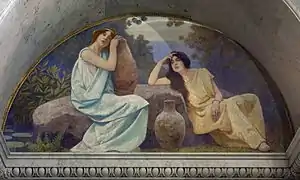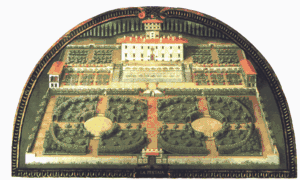Lunette
A lunette (French lunette, "little moon") is a half-moon shaped architectural space, variously filled with sculpture, painted, glazed, filled with recessed masonry, or void. A lunette is formed when a horizontal cornice transects a round-headed arch at the level of the imposts, where the arch springs. If a door is set within a round-headed arch, the space within the arch above the door, masonry or glass, is a lunette. If the door is a major access, and the lunette above is massive and deeply set, it may be called a tympanum.


The term is usefully employed to describe the section of interior wall between the curves of a vault and its springing line. A system of intersecting vaults produces lunettes on the wall surfaces above a cornice. The lunettes in the structure of the Sistine Chapel ceiling inspired Michelangelo to come up with inventive compositions for the spaces.
In the Neoclassical architecture of Robert Adam and his French contemporaries like Ange-Jacques Gabriel, a favorite scheme set a series of windows within shallow blind arches. The lunettes above lent themselves to radiating motifs: a sunburst of bellflower husks, radiating fluting, a low vase of flowers, etc.
A lunette may also be segmental, and the arch may be an arc taken from an oval. The spaces are still lunettes.
A lunette window is commonly called a half-moon window, or fanlight when bars separating its panes fan out radially.

Flemish painter Giusto Utens rendered a series of Medicean villas in lunette form for the third grand duke of Tuscany, Ferdinando I, in 1599–1602:[1]
See also
References
- Mignani, Daniela (1995) [1991]. The Medicean Villas by Giusto Utens (2nd ed.). Florence: Arnaud. ISBN 88-8015-000-6.